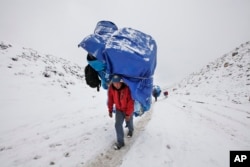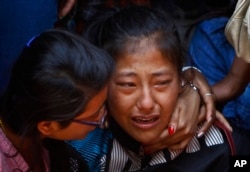For mountaineers, the allure of Everest is obvious: As the highest place on Earth, it’s an accomplishment unparalleled.
For the Sherpas who live at the foot of the mountain, it is a holy place called Chomolunga — Mother God of the Earth.
It was first conquered in 1953 by New Zealander Edmund Hillary and local Sherpa Tenzing Norgay, and since then it has proven deadly for both.
There are more than 200 human bodies scattered along the mountainside, and another four have died on its slopes so far this year.
All of that is explored in a new documentary called Sherpa by Jennifer Peedom, which premiered on the Discovery channel this year.
Disaster unfolds
The film details the events of April 18, 2014, when a 14 million-ton block of ice crashed down onto the climbing route, killing 16 Sherpas.
And it is the Sherpas, not the climbers they ferry up and down the mountainside, upon whom the documentary focuses.
It is a film of contrasts: The Sherpas serve tea and hot towels to one mountaineer, Tim Medvetz, during their ascent.
"Roughing it on Mount Everest," he jokes to the camera. "Hot towels and tea in the morning."
But these luxuries come at a price, and it is one the film says is paid primarily by the Sherpas, who work every climbing season for a small fraction of the profit that expedition associations and the Nepalese government make at their expense.
The visitors prep for the climb in their spacious tents while the Sherpas pay their respects to the gods of the mountain, praying for a safe ascent while their families anxiously await their return.
Doing anything at this altitude is risky, and can be deadly. And so it is ironic that lavish summit expeditions designed to make the climb less extreme pose the most risk for climbers and Sherpas alike.
Norbu Tenzing Norgay, the vice president of the Himalayan Foundation, is the son of Tenzing Norgay, the first Sherpa to climb Mount Everest.
"Can we reduce that risk?" he said. "Yes. If people aren't carrying special machines and heaters and pads so that their clients can sleep comfortably, yes, you can reduce the risk."
Making it worth the risk
The documentary highlights the inequity and the cultural rift between the Sherpas, who see the climb as a pilgrimage, and the Westerners, who see it as a challenge.
But it is the Sherpas whose lives depend on the expedition business.
Each Sherpa makes about $5,000 a season, while their farming counterparts make $700. But that amount pales next to the $70,000 or $100,000 each climber pays for the trip of his dreams.
The lion's share goes to the businesses and the government, says Norbu Tenzing Norgay.
"The average Sherpa now gets $15,000 in insurance, should something bad happen," he said. "And that's up by $5,000 since 2014. But if you go back a number of years when somebody died on Everest, the average Sherpa was able to build a house, send his kids to school and have a tea house. In these days, the insurance barely covers the cost of a funeral."
And there have been many funerals, but the April 2014 avalanche was the last straw.
"Sixteen people dying at the same time, it's a huge, huge shock," said Dawan Steven Sherpa. "Once it started to sink in, the anger got distinctly pointed at the government — the feel that the government has been always benefiting off the labor of the Sherpas, the lives of the Sherpas, and never put anything back.
The solution for many Sherpas is to go around the middleman and start their own mountain expedition groups.
Their goal: to control the experience, and keep themselves and climbers safe on a mountain they revere.













